Abstract
Introduction:
Dental caries is the most common chronic disease of childhood that interferes with normal nutrition intake, speech, and daily routine activities. Dental caries affects people of all ages with the highest priority risk group being school-going children. Hence, this cross-sectional study helps to determine the prevalence and to compare the dental caries experience among 5- to 12-year-old school-going children of Chandigarh using dft/DMFT and SiC index.
Materials and Methods:
The present study was conducted among 3354 school children in the age group of 5 to 12 years. The subjects were selected from four randomly selected schools in Chandigarh. Independent t-test and one-way analysis of variance were used to compare the mean difference at 5% significance level (P < 0.05).
Results:
The prevalence of dental caries was found to be 46.9% with a mean dft and DMFT score of 1.36 ± 2.16 and 0.28 ± 0.80, respectively. The SiC index score for primary and permanent dentition were 3.53 ± 2.53 and 0.85 ± 1.20, respectively. The dft scores declined progressively as the age advanced whereas the DMFT scores increased from 5 to 12 years.
Conclusion:
Caries prevalence was high in primary than permanent dentition. Comparison between dft/DMFT and SiC indices indicated there is a subgroup that presented with a higher caries rate.
Keywords: dft/DMFT, school children, SiC
Introduction
Dental caries is a multifactorial, chronic childhood disease and is the outcome of a multiple factors like diet, microorganisms, tooth morphology, saliva, trace elements, and genetic predisposition. Apart from these, other related factors like individual, social, environmental, and cultural factors also influences dental caries.[1,2,3,4,5] Dental caries affects people of all ages with the highest priority risk group being school-going children.
School years cover a period from childhood to adolescence. These are important milestones in human lives where lifelong substantial oral health behaviors, as well as beliefs and attitudes, are being established. School children are receptive during this period and the earlier the habits are developed, the long lasting the impact on oral health.[6] Children who have poor oral health are 12 times subjected to have more limited activity days including missing schools than those who do not.[7]
More than 50 million hours are lost from schools annually due to oral hygiene-related diseases.[8] Studies have shown that school hours are missed due to high decayed component in both primary and permanent dentitions.[9] Similar findings have been reported in surveys of Brazilian preschool children and American native children.[10] Hence, schools can provide an ideal place to reach millions of children and ensure strong foundations for a healthy lifestyle at an early stage.
A WHO report shows that 60–90% of schoolchildren worldwide have experienced dental caries and it is most prevalent in Asian and Latin American countries.[11] The U.S. Department of Health and Human Services 2014 report stated that dental caries is the most common chronic disease among children and it is five times more common than asthma and seven times more common than seasonal allergies.[12]
Polarization of dental caries is occurring on a worldwide basis, where the prevalence of dental caries is decreasing in developed countries, increasing in less-developed countries, and is epidemic in some countries with emerging economies. The prevalence of dental caries is declining in developing countries mainly due to a more sensible approach to sugar intake, good oral hygiene measures, and preventive programs. But there is also a simultaneous increase in caries prevalence in developing countries which is mainly attributed to the fact that oral health care system in these countries concentrates on curative care and not on community-based prevention and oral health promotion.[13]
The WHO estimation of global DMFT for 12-year-old children reported that in the 188 countries which were included in their database, on a global basis, 200, 335, and 280 teeth were decayed, filled, or missing (WHO Oral Health Database, Country/Area Profile Program, 2004).[14]
According to the National Oral Health Survey, 2002–2003, caries prevalence in India was 51.9% (mean deft = 2), 53.8% (mean DMFT = 1.8), and 63.1% (mean DMFT = 2.4) at ages 5, 12, and 15 years.[15,16] Therefore, prevalence studies on dental caries in India have shown results ranging from 31.5% to 89%.[17,18,19,20,21]
Chandigarh is a union territory of India and is going through a rapid phase of Westernization with changing lifestyles and dietary habits.[22]
An earlier cross-sectional study conducted on 6-, 9-, 12-, and 15-year-old school children of Chandigarh showed a mean deft score of 4.0 ± 3.6 in 6 year olds and 4.61 ± 3.14 in 9 year olds, whereas the mean DMFT scores of 12- and 15-year-old children were found to be 3.03 ± 2.52 and 3.82 ± 2.85, respectively.[18] Another study conducted during 2008 to 2009 showed that 5- and 12-year-old children had a mean DMFT of 1.8 ± 2.1 while the mean DMFT of the 12-year-old group was 0.5 ± 0.6.[22]
Dental caries prevalence is expressed as the mean DMFT value which does not correctly reflect the skewed distribution, leaving high caries subgroups unidentified in the population. Hence, a new index called the “Significant caries index” (SiC) was proposed by WHO which enables to identify individuals with the highest caries scores in each population.[23]
The SiC index gives the mean dft/DMFT of one third of the study group with the highest caries score. According to oral health goal proposed by WHO/FDI, the SiC index for countries should have been less than DMFT 3 in 12-year-old children by the year 2015.[24]
Hence, this present study was conducted as a part of the extensive screening, a joint initiative of Saveetha University and Times of India to assess the prevalence and comparison of dental caries experience among 5- to 12-year old school-going children of Chandigarh using the dft/DMFT and SiC index.
Materials and Methods
The present cross-sectional study was conducted to create awareness about oral health among school children in India. There are 29 states and 7 union territories in India. On a map, India was divided in to North, South, East, West, and Central India. A total of 16 places and 79 schools were selected from all the zones which include 21 schools from North, 41 schools from South, 4 schools from East, 9 schools from West, and 4 schools from Central India. Of the 79 schools, four schools were randomly selected from Chandigarh city.
Chandigarh is a union territory of India and the common capital of the states of Punjab and Haryana with a population of 1,054,680 and literacy rate of 86.43%. There are about 108 government-aided schools and 72 recognized private schools in Chandigarh. A list of schools from all the four main zones of Chandigarh was obtained and a total of 3354 school children within the age group of 5–12 years were examined for dentition status from the four selected schools of Chandigarh on November 27, 2014.
School children in the age group of 5 to 12 years who were present on the day of examination were included in the study. Children who were under long-term medications that affect the oral health, were physically or mentally challenged, were not willing to participate, and absent on the day of examination were excluded from the study.
Prior to the start of the study, ethical clearance was obtained from the Institutional Ethics Committee, Saveetha University (SRB reference No: SRB/SDMDS12ORT15) 3.10.2015. School permissions were obtained from The Educational Department of Chandigarh. Written group informed consent was obtained from the headmasters of the school. Data Collection was scheduled in the month of November 2014.
Examiners were calibrated through a series of clinical training in the Department of Public Health Dentistry, Saveetha Dental College, Chennai prior to the start of the study and were assisted by a recorder. Interexaminer reliability was calculated by examining a group of 20 school children and the reexamination was carried out 30 minutes after the initial examination and hence a kappa value of 0.78 was obtained which denoted a substantial level of agreement between the examiners.
The examination of the subjects as per the guidelines of the American Dental Association for Type III examination was carried out in concerned school premises using disposable mouth mirror, dental explorer, and torch light with subjects seated comfortably on ordinary chair with back rest and the examiner sitting in front of the child. Clinical examination included the assessment of dental caries using dft index by Gruebbel for primary dentition and DMFT index by Klein, Palmer, Knutson for permanent dentition recorded on a structured format. The tooth was considered carious (D component) if there was visible evidence of a cavity, including untreated dental caries. The missing (M component) included teeth with indications for extractions or teeth extracted due to caries. The filled (F component) included filled teeth.
The structured format consisted of three sections. The first section collected demographic information of the participants such as name, age in years, gender, and their location. The second part of the format consisted of two questions regarding oral hygiene practices which included frequency of cleaning and materials used to clean the teeth. The third part consisted of data regarding dental caries experience which was recorded using dft index for primary dentition and DMFT index for permanent dentition.
SiC index was calculated by sorting the individuals according to their DMFT and dft scores and selecting the one third of the population with the highest caries values. Finally, the mean DMFT and dft for that subgroup was calculated which gives the SiC score for that subgroup.
Data was entered in Microsoft Excel spreadsheet and analyzed using SPSS software (version 20). Descriptive statistics were used for data summarization and presentation. Independent t-test and one-way ANOVA were used to compare the mean difference. The level of significance was set at a value of P < 0.05.
Results
Table 1 depicts the distribution of study subjects. The study sample consisted of 3354 subjects of which 1941 (57.9%) were males and 1413 (42.1%) were females. Out of 3354 study subjects, 1778 (53.1%) had caries and 1576 (46.9%) were caries free [refer Figure 1]. It is apparent from Figure 2 that caries prevalence was found to be higher among males (57.1%) than females (42.9%). Figure 3 shows the prevalence of caries with respect to age groups. The study subjects exhibited a caries prevalence of 54.2% between 5 to 6 years and gradually increased to 59.8% between 7 to 8 years and subsequently decreased to 56.6% between 9 to 10 years and further declined to 39.8% between 11 to 12 years. Figures 4 and 5 show the mean dental caries experience in the primary and permanent dentition using dft/DMFT and SiC index. As the age advanced, the mean dft and SiC scores in the primary teeth decreased where as in permanent teeth, the mean DMFT and SiC score increased. Figure 6 shows a Skewed distribution of dft score in primary dentition among the whole population. Histogram of dft showed the positive skewness of caries with more than half of the studied population having zero dft. Figure 7 shows a Skewed distribution of SiC score in primary dentition among the highest one-third group. Among one-third of the population having highest dft, the distribution was positively skewed with more than half of the people having 3 dft. Table 2 depicts the comparison of mean dft/DMFT and SiC score based on gender. The mean dft and SiC scores among male and female in the primary dentition were found to be significant statistically using Independent ‘t’test (P < 0.05). Table 3 shows a comparison of mean dft/DMFT and SiC score among various age groups which was found to be significant statistically (P < 0.001) using one way ANOVA test.
Table 1.
Distribution of study subjects based on age and gender
| Age group (years) | Gender | |||||
|---|---|---|---|---|---|---|
| Male | Female | Total | ||||
| n | Percentage | n | Percentage | n | Percentage | |
| 5-6 | 268 | 8 | 223 | 6.9 | 491 | 14.9 |
| 7-8 | 559 | 16.7 | 402 | 11.9 | 961 | 28.6 |
| 9-10 | 637 | 19 | 435 | 12.9 | 1072 | 31.9 |
| 11-12 | 477 | 14.2 | 353 | 10.4 | 830 | 24.6 |
| Total | 1941 | 57.9 | 1413 | 42.1 | 3354 | 100 |
Figure 1.
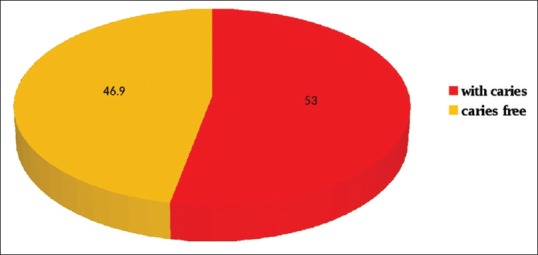
Prevalence of dental caries among the study subjects
Figure 2.
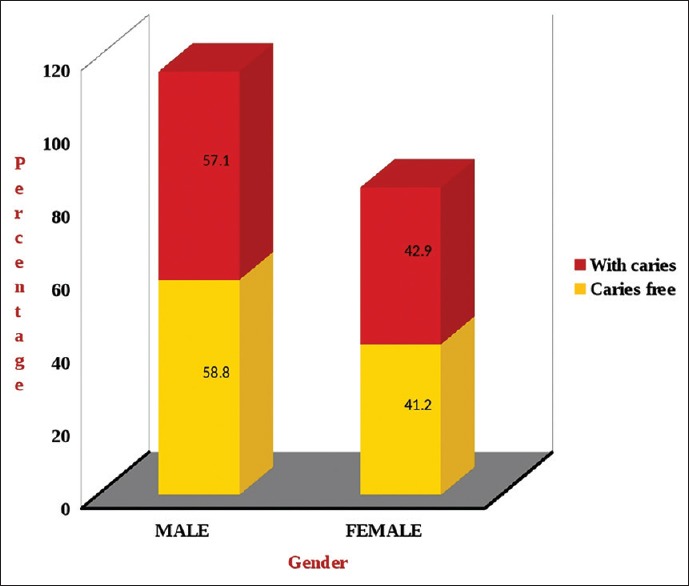
Prevalence of dental caries according to gender
Figure 3.
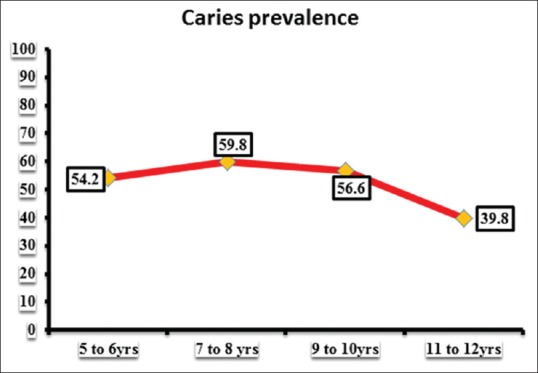
Prevalence of caries with respect to age groups
Figure 4.
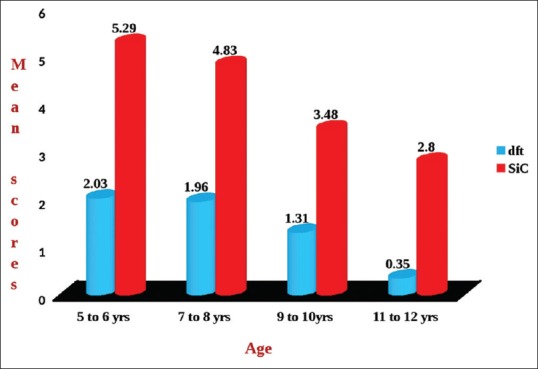
Mean dental caries experience in primary dentition using dft and SiC index
Figure 5.
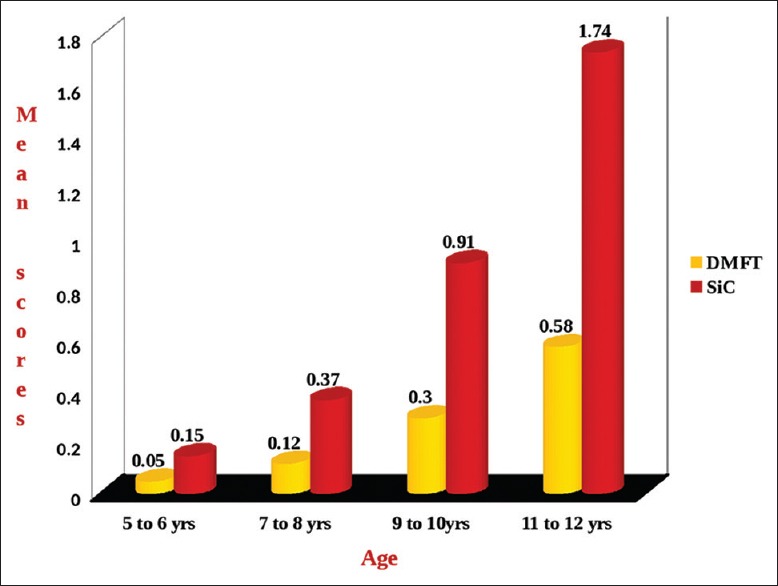
Mean dental caries experience in permanent dentition using DMFT and SiC index
Figure 6.
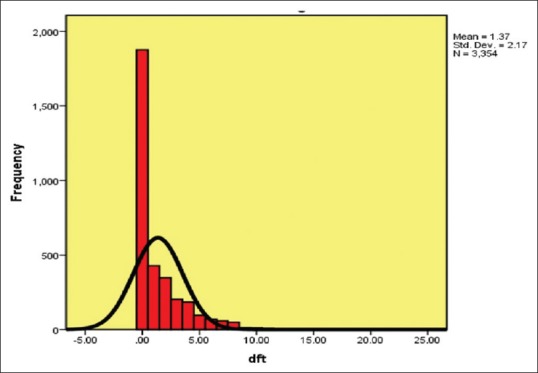
Skewed distribution of dft score in primary dentition among whole population
Figure 7.
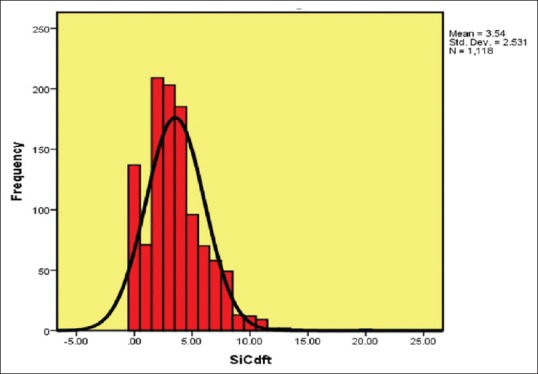
Skewed distribution of SiC score in primary dentition among the highest one-third group
Table 2.
Comparison of mean dft/DMFT and SiC score based on gender
| Caries Index | Male | Female | Overall | P |
|---|---|---|---|---|
| Primary dft | 1.42±2.21 | 1.29±2.10 | 1.36±2.16 | 0.02* |
| SiC | 3.92±2.24 | 3.59±2.26 | 3.53±2.53 | 0.04* |
| Permanent DMFT | 0.27±0.80 | 0.29±0.79 | 0.28±0.80 | 0.50 |
| SiC | 0.83±1.22 | 0.87±1.17 | 0.85±1.20 | 0.53 |
Independent ‘t’ test (P<0.05)
Table 3.
Comparison of mean dft/DMFT and SiC score among various age groups
| Caries Index | Age group | n | Mean±SD | P |
|---|---|---|---|---|
| Primary dft Score | 5-6 | 491 | 2.03±2.86 | <0.001* |
| 7-8 | 961 | 1.96±2.44 | ||
| 9-10 | 1072 | 1.31±1.88 | ||
| 11-12 | 830 | 0.35±1.00 | ||
| Total | 3354 | 1.36±2.16 | ||
| SiC Score | 5-6 | 164 | 5.29±2.7 | <0.001* |
| 7-8 | 320 | 4.83±2.08 | ||
| 9-10 | 357 | 3.48±1.80 | ||
| 11-12 | 277 | 1.06±1.50 | ||
| Total | 1118 | 3.53±2.53 | ||
| Permanent DMFT Score | 5-6 | 491 | 0.05±0.35 | <0.001* |
| 7-8 | 961 | 0.12±0.48 | ||
| 9-10 | 1072 | 0.30±0.81 | ||
| 11-12 | 830 | 0.58±1.11 | ||
| Total | 3354 | 0.28±0.80 | ||
| SiC Score | 5-6 | 164 | 0.15±0.59 | <0.001* |
| 7-8 | 320 | 0.37±0.78 | ||
| 9-10 | 357 | 0.91±1.20 | ||
| 11-12 | 277 | 1.74±1.30 | ||
| Total | 1118 | 0.85±1.20 |
One way ANOVA, significance level P<0.001
Discussion
Dental caries is the most common chronic disease of childhood that interferes with normal nutrition intake, speech, self-esteem, and daily routine activities, because the caries pain adversely affects the normal food intake. This results in underweight children with abnormal cognitive development.[25] Despite incredible scientific advances and the fact that caries is preventable, the disease continues to be a major public health problem.[22]
The World Health Organization (W.H.O) has ranked dental caries, as number three among all chronic noncommunicable diseases that require worldwide attention for prevention and treatment.[26]
The use of DMFT and dft indices has been an accepted practice for assessing the prevalence and severity of caries in a population.[27] Mean DMFT and dft values are an average of all the members of the population, irrespective of the distribution of the severity of the disease within the population.[28] However, the epidemiologic changes in the dental caries pictured during the last 2–3 decades, have made it increasingly evident that mean DMFT and dft values do not capture the polarized caries development with a more skewed distribution of caries.[29]
Hence an attempt has been made in the present study to assess the prevalence and to compare the dental caries experience among 5- to 12-year-old school-going children of Chandigarh using dft/DMFT and SiC index.
The study sample consisted of 3354 subjects of which 1941 (57.9%) were males and 1413 (42.1%) were females. 491 (14.9%) subjects were between 5 to 6 years of age, 961 (28.6%) were between 7 to 8 years, 1072 (31.9%) between 9 to 10 years, and 830 (24.6%) were between 11 to 12 years of age.
The results of the present study showed that 2100 (62.6%) study subjects brushed their teeth once daily and only 1254 (37.4%) brushed their teeth twice daily. Very similar results were also reported in a study conducted by Harikiran et al.[30] among 11- to 12-year-old school children of Bangalore. They found that only 38.5% of the children brushed their teeth two or more times a day. In contrast to the above results, a study done by Lian et al.[31] among secondary school students showed that about 95.7% of the respondents brush their teeth at least twice per day. The decreased frequency of tooth brushing in the present study is mainly due to the lack of knowledge on importance of tooth brushing and its effect on dental health.
The overall prevalence of dental caries in the present study was found to be 53.1% and was consistent with the prevalence of 55.3% observed in a study conducted by Chatufale JD, et al.[32] among 5 to 12 years old children. On the contrary, a higher prevalence of dental caries of 68.5% was reported among 6–12 year children in Kerala by Retnakumari N[33] and a prevalence rate of 65% was reported among 4 to 17 years old children by Bajaj M, et al.[34]. The reason for the prevalence of lower dental caries in the present study could be attributed to the use of fluoridated tooth paste by the children. A very low caries prevalence of 18.01% was observed by Gurdeep Singh et al.[35] among 6 to 12 year children which is attributed to the simple, traditional fibrous food consumed by children and good oral hygiene practices as reported by the author.
The highest caries prevalence was found among males (57.1%) than females (42.9%) These findings are similar to the studies of Arora Sachit A, et al.,[36] Yevenes et al.[37] This difference could be attributed to the diet as more priority is given to a male child than a female child in the Indian society. Moreover, females are found to have better personal hygiene than males. On the contrary females were found to have higher caries prevalence by Poonam Shingare et al.[38] and Mosha HJ, et al.[39]
In the present study, the difference in the dft/DMFT between the four age groups in the study was found to be highly significant. The dft scores declined progressively as the age advanced whereas the DMFT scores increased from 5 to 12 years. The decline in dft scores is attributed to the reduction in the number of primary teeth with age due to exfoliation. The increase in DMFT coincides with the eruption of permanent teeth. A similar trend was observed by Sudha P, et al.[40] and Rao et al.[41]
The study subjects exhibited caries prevalence of 54.2% between 5 to 6 years and gradually increased to 59.8% between 7 to 8 years and subsequently decreased to 56.6% between 9 to 10 years and further declined to 39.8% between 11 to 12 years. The difference observed could be attributed to the fact that the carious deciduous first and second molars are replaced by newly erupted premolars by the age of 12 years. Dash et al.[19] also observed the similar pattern in which caries were increasing from 5 years to 8 years but subsequently decreased at 11 and 15 years of age.
As expected, the SiC index score was higher in all comparisons with dft and DMFT which is agreed with other studies.[29,42] A comparison between dft/DMFT and SiC indices indicated a subgroup that presented with a higher caries rate.
In the present study, the skewed distribution was calculated by selecting the one third of the studied population with the highest dft/DMFT caries score. The dft histogram showed the positive skewness of caries with more than half of the studied population having zero dft. Among one-third of the population having highest dft, the distribution was positively skewed with more than half of the people having 3 dft whereas the histogram of DMFT showed the positive skewness of caries with more than half of the studied population having zero dft. Among one-third of the population having highest DMFT, the distribution was positively skewed with more than half of the people having zero DMFT.
With reference to the above findings, it would be expected that the relative stability of the subgroups with a high caries pattern could be used to conduct an oral health awareness initiative for early identification of the children with highest caries prevalence, as they would be considered as a special group for ending up in late adolescence with considerably higher caries rate than the remainder of the population. The highest caries prevalence among school children influences the oral health–related quality of life and in advanced stages, it ends up in systemic infection. Public health solutions for oral diseases are most effective when they are integrated with those for other NCDs and with national public health programs. The WHO Global Oral Health Programme assists member states by supporting to strengthen oral health systems based on a people-centered healthcare approach as a part of primary health care (PHC).[43]
Conclusion
According to the oral health goal proposed by WHO for the year 2000, 50% of 5- to 6-year-old children should be caries free, and the average DMFT should not be more than 3 at 12 years of age.[44] In the present study, it was observed that 45.8% of 5- to 6 -year-old children were caries free and the mean DMFT was 0.58 for 11- to 12-year-old children. This shows that the caries prevalence was found to be high in primary than permanent dentition and, hence, WHO global oral health goal for 11 to 12 years were achieved but not for 5 to 6 years of age in Chandigarh.
WHO/FDI proposed that the SiC index should be less than DMFT 3 among 12 year olds by the year 2015.[24] In the present study, the SiC score for the mean DMFT among one third of the population with highest caries score was found to be 1.74. Therefore, the WHO/FDI target level of SiC index 3 is achieved in Chandigarh. Still, as public health professionals, we still aim at achieving zero SiC score for all school going children in Chandigarh.
Financial support and sponsorship
Nil.
Conflicts of interest
There are no conflicts of interest.
Acknowledgements
The authors would like to thank Dr. Anu thomas, Dr. Parvathy Premnath, Dr. Anupama Mani, Dr. Nithin M.G, Dr. N. Nagappan, Dr. Ekta Priya, Dr. K.B. Laliytha, Dr. Manprit Khambay, and Dr. Neeraja Ramadurai for their support to conduct the school-based oral health survey in Chandigarh.
References
- 1.Saxena S, Shashikiran ND. Prevalence of dental caries and treatment needs among hemophilic children of Kota city, Rajasthan. Ann Ess Dent. 2010;2:18–21. [Google Scholar]
- 2.Lukacs JR, Largaespada LL. Explaining sex differences in dental caries prevalence: Saliva, hormones, and “life-history” etiologies. Am J Hum Biol. 2006;18:540–55. doi: 10.1002/ajhb.20530. [DOI] [PubMed] [Google Scholar]
- 3.Faggiano F, Stanislao FD, Lemma P, Renga G. Role of social class in caries occurrence in 12 year olds in Turin, Italy. The European Journal of Public Health. 1999;9:109–13. [Google Scholar]
- 4.Doifode VV, Ambadekar NN, Lanewar AG. Assessment of oral health status and its association with some epidemiological factors in population of Nagpur, India. Indian J Med Sci. 2000;54:261–9. [PubMed] [Google Scholar]
- 5.Adekoya-Sofowora CA, Nasir WO, Oginni AO, Taiwo M. Dental caries in 12-year-old suburban Nigerian school children. Afr Health Sci. 2006;6:145–50. doi: 10.5555/afhs.2006.6.3.145. [DOI] [PMC free article] [PubMed] [Google Scholar]
- 6.Goel R, Vedi A, Goyal P, Veeresha KL, Sogi GM. Prevalence of dental caries among 12-15 years old school children in Ambala district of Haryana state. J Dent Res Updates. 2014;1:1–5. [Google Scholar]
- 7.WHO information series on school health: Document Eleven: Geneva. 2003 [Google Scholar]
- 8.Park K. Parks: Text Book of Preventive and Social Medicine. 20th ed. Jabalpur: Banarasi Das Bhanot Publishers; 2009. [Google Scholar]
- 9.Jurgensen N, Petersen PE. Oral health and the impact of socio behavioural factors in a cross sectional survey of 12-year old school children in Laos. BMC Oral Health. 2009;9:29. doi: 10.1186/1472-6831-9-29. [DOI] [PMC free article] [PubMed] [Google Scholar]
- 10.Moure-Leite FR, Ramos-Jorge J, Ramos-Jorge ML, Paiva SM, Vale MP, Pordeus IA. Impact of dental pain on daily living of five-year-old Brazilian preschool children: Prevalence and associated factors. Eur Arch Paediatr Dent. 2011;12:293–7. doi: 10.1007/BF03262826. [DOI] [PubMed] [Google Scholar]
- 11.Petersen PE, Bourgeois D, Ogawa H, Estupinan-Day S, Ndiaye C. The global burden of oral diseases and risks to oral health. Bull World Health Organ. 2005;83:661–9. [PMC free article] [PubMed] [Google Scholar]
- 12.U.S. Department of Health and Human Services. Oral Health in America: A Report of the Surgeon General –– Executive Summary. Rockville, MD, National Institute of Health and Craniofacial Research. [Last accessed on 2014 Feb 21]. Available from: http://www.nidcr.nih.gov/datastatics/surgeongeneral/report/executivesummary .
- 13.Studervant CM, Roberson TM, Heymann HO, Studervant JR. The Art and Science of Operative Dentistry. 3rd ed. Missouri: Mosby Co; 1995. pp. 62–3. Study of prevalence of dental caries in an urban area of Nagpur. JIDA 1993;64:389-92. [Google Scholar]
- 14.Bratthall D. Estimation of global DMFT for 12 year olds in 2004. Int Dent J. 2005;55:370–2. doi: 10.1111/j.1875-595x.2005.tb00048.x. [DOI] [PubMed] [Google Scholar]
- 15.Bönecker M, Cleaton-Jones P. Trends in dental caries in Latin American and Caribbean 5-6- and 11-13-year-old children: A systematic review. Community Dent Oral Epidemiol. 2003;31:152–7. doi: 10.1034/j.1600-0528.2003.00009.x. [DOI] [PubMed] [Google Scholar]
- 16.Bagramian RA, Garcia-Godoy F, Volpe AR. The global increase in dental caries. A pending public health crisis. Am J Dent. 2009;22:3–8. [PubMed] [Google Scholar]
- 17.Damle SC, Patel AR. Caries prevalence and treatment need amongst children of Dharavi, Bombay, India. Community Dent Oral Epidemiol. 1994;22:62–3. doi: 10.1111/j.1600-0528.1994.tb01572.x. [DOI] [PubMed] [Google Scholar]
- 18.Tewari A, Chawla HS. Study of prevalence of dental caries in an urban area of India (Chandigarh) J Indian Dent Assoc. 1977;49:231–9. [Google Scholar]
- 19.Dash JK, Sahoo PK, Bhuyan SK, Sahoo SK. Prevalence of dental caries and treatment needs among children of Cuttack (Orissa) J Indian Soc Pedod Prev Dent. 2002;20:139–43. [PubMed] [Google Scholar]
- 20.Dhar V, Jain A, Van Dyke TE, Kohli A. Prevalence of dental caries and treatment needs in the school-going children of rural areas in Udaipur district. J Indian Soc Pedod Prev Dent. 2007;25:119–21. doi: 10.4103/0970-4388.36560. [DOI] [PubMed] [Google Scholar]
- 21.Saravanan S, Kalyani V, Vijayarani MP, Jayakodi P, Felix J, Arunmozhi P, et al. Caries prevalence and treatment needs of rural school children in Chidambaram Taluk, Tamil Nadu, South India. Indian J Dent Res. 2008;19:186–90. doi: 10.4103/0970-9290.42948. [DOI] [PubMed] [Google Scholar]
- 22.Sohi RK, Gambhir RS, Veeresha KL, Randhawa AK, Singh G. Assessment of prevalence of dental caries among 5 and 12-year-old schoolchildren in Chandigarh (U.T.), India. Arch Oral Biol. 2012;8:39–45. [Google Scholar]
- 23.Bratthall D. Introducing the significant caries index together with a proposal for a new global oral health goal for 12-year-olds. Int Dent J. 2000;50:378–84. doi: 10.1111/j.1875-595x.2000.tb00572.x. [DOI] [PubMed] [Google Scholar]
- 24.Arora B, Khinda VIS, Kallar S, Bajaj N, Brar GS. Prevalence and comparison of dental caries in 12 year old school going children in rural and urban areas of Ferozepur city using sic index. Dent Oral Craniofac Res. 2015;1:38–41. [Google Scholar]
- 25.Grewal H, Verma M, Kumar A. Prevalence of dental caries and treatment needs in the rural child population of Nainital District, Uttaranchal. J Indian Soc Pedod Prev Dent. 2009;27:224–6. doi: 10.4103/0970-4388.57657. [DOI] [PubMed] [Google Scholar]
- 26.Marrs JA, Trumbley S, Malik G. Early childhood caries: Determining the risk factors and assessing the prevention strategies for nursing intervention. Pediatr Nurs. 2011;37:9–15. [PubMed] [Google Scholar]
- 27.Dye BA, Tan S, Smith V, Lewis BG, Barker LK, Yhornton-Evans G. Trends in oral health status: United States, 1988-1994 and 1999-2004. National Center for Health Statistics. Vital Health Stat, 11. 2007. Publication No. (PHS) 2007-1698. [PubMed] [Google Scholar]
- 28.Gasgoos SS, Ghada D, Sayagh A, Jazrawi KH. Evaluation of dental caries prevalence among children in Mosul City centre using significant caries index. Dent J. 2012;12:191–7. [Google Scholar]
- 29.Ditmyer M, Dounis G, Mobley C, Schwarz E. Inequalities of caries experience in Navada youth expressed by DMFT index vs. Significant caries index (SiC) over time. BMC Oral Health. 2011;11:12. doi: 10.1186/1472-6831-11-12. [DOI] [PMC free article] [PubMed] [Google Scholar]
- 30.Harikiran AG, Pallavi SK, Hariprakash S, Ashutosh, Nagesh KS. Oral health-related KAP among 11 to 12 year old school children in a government-aided missionary school of Bangalore city. Ind J Dent Res. 2008;19:236–42. doi: 10.4103/0970-9290.42957. [DOI] [PubMed] [Google Scholar]
- 31.Lian CW, Phing TS, Chan CS, Shin BC, Baharuddin LH, Che’Jalil ZB. Oral health knowledge, attitude and practice among secondary school students in Kuching, Sarawak. Arch Orofacial Sci. 2010;5:9–16. [Google Scholar]
- 32.Chatufale JD, Goyal RC. A cross sectional study of factors related to oral health in rural area of Loni, Westren Maharashtra. Ind J Commun Med. 2002;27:74–6. [Google Scholar]
- 33.Retnakumari N. Prevalence of dental caries and risk assessment among primary school children of 6-12 years in Varkala Municipal area of Kerala. J Indian Soc Pedod Prev Dent. 1999;17:135–42. [PubMed] [Google Scholar]
- 34.Bajaj M, Blah BC, Goyal M, Jain M, Joshi A, Ko HH, et al. Prevalevce of dental problemsin School children-A study in a rural community in Haryana. Ind J Commun Med. 1989;14:106–9. [Google Scholar]
- 35.Singh G, Kaur G, Mengi V, Singh B. A study of dental caries among school children in rural area of Jammu. Ann of Dent Spec. 2014;2:1–5. [Google Scholar]
- 36.Sachit AA, Sumeet S, Ahuja P, Singh D, Chandna A. Prevalence of dental caries among pre-school children of Greater Noida City, UP (India) Indian J Dent Sci. 2012;4:4–6. [Google Scholar]
- 37.Yevenes I, Bustos BC, Ramos AA, Espinoza RM, Jara MN, Petrasic Smith L. Prevalence of dental caries in pre-school children in Penaflor, Santiago, Chile. Rev Odonto Cienc. 2009;24:2:116–9. [Google Scholar]
- 38.Shingare P, Jogani V, Sevekar S, Patil S, Jha M. Dental caries prevalence among 3 to 14 year old school children, Uran, Raigad district, Maharashtra. J Contemp Dent. 2012;2:11–4. [Google Scholar]
- 39.Mosha HJ, Senkoro AJ, Masalu JRP, Kahabuka F, Mandari G, Mabelya L, et al. Oral health status and treatment needs among Tanzanian of different age groups, Tanzania. Tanzania Dent J. 2005;12:18–27. [Google Scholar]
- 40.Sudha P, Bhasin S, Anegundi RT. Prevalence of dental caries among 5-13 year old children of Mangalore city. J Indian Soc Pedod Prev Dent. 2005;23:74–9. doi: 10.4103/0970-4388.16446. [DOI] [PubMed] [Google Scholar]
- 41.Rao A, Sequeira SP, Peter S. Prevalence of dental caries among school children of Moodbidri. J Indian Soc Pedod Prev Dent. 1999;17:45–8. [PubMed] [Google Scholar]
- 42.Namal N, Yüceokur AA, Can G. Significant caries index values and related factors in 5–6-year-old children in Istanbul, Turkey. East Mediterr Health J. 2009;15:178–84. [PubMed] [Google Scholar]
- 43.World Health Organization. Shanghai Declaration on promoting health in the 2030 Agenda for Sustainable Development. Published 2016. [Last accessed on 2019 Sep 24]; doi: 10.1093/heapro/daw103. [DOI] [PubMed] [Google Scholar]
- 44.Aggeryd T. Goals for oral health in the year 2000: Cooperation between WHO, FDI and the national dental associations. Int Dent J. 1983;33:55–9. [PubMed] [Google Scholar]


